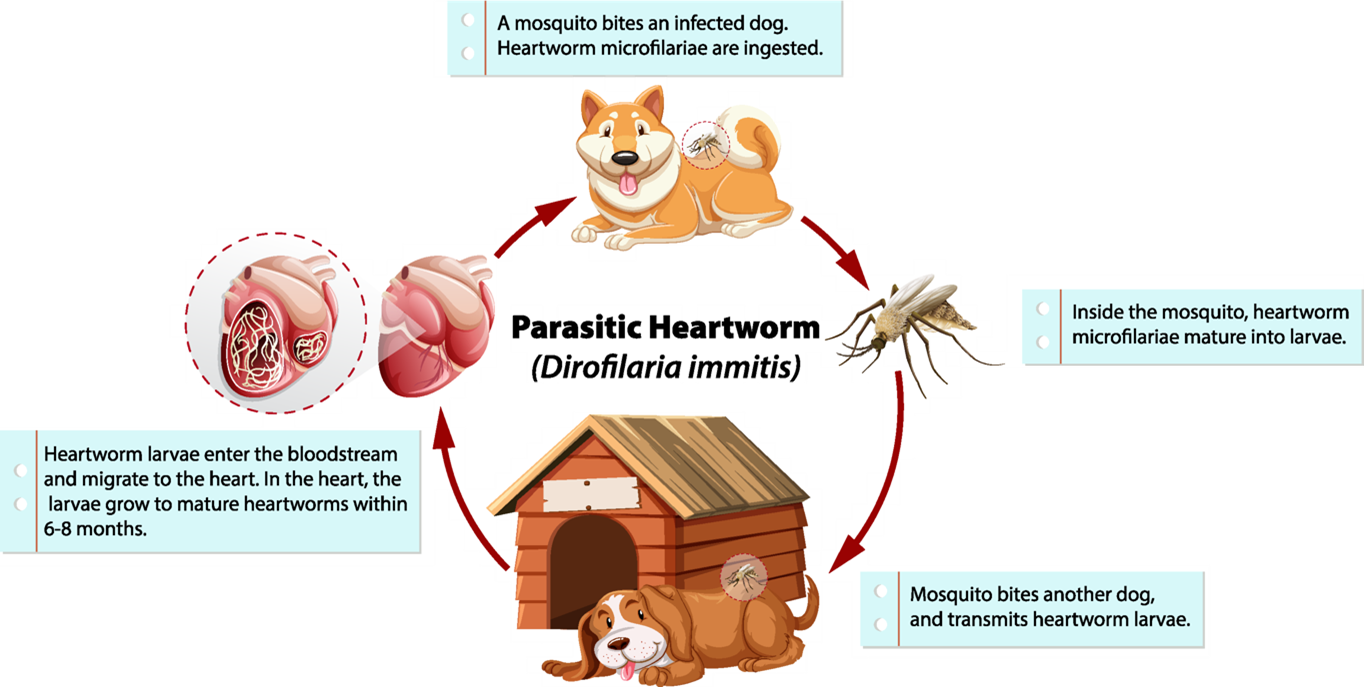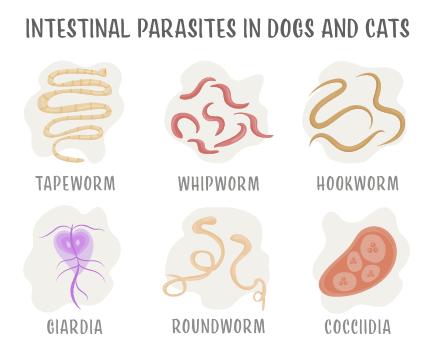Parasite Prevention
| Pet | Prevention Product | Fleas | Ticks | Heartworm | Roundworm | Hookworm | Tapeworm | Eat Mites |
|---|---|---|---|---|---|---|---|---|
| Dogs | Nexgard Spectra | ✔ | ✔ | ✔ | ✔ | ✔ | ✔ | |
| Nexgard | ✔ | ✔ | ✔ | |||||
| Heartgard | ✔ | ✔ | ✔ | |||||
| Bravecto | ✔ | ✔ | ||||||
| K9 Advantix II | ✔ | ✔ | ||||||
| Cats | Nexgard Combo | ✔ | ✔ | ✔ | ✔ | ✔ | ✔ | ✔ |
| Revolution Plus | ✔ | ✔ | ✔ | ✔ | ✔ | ✔ | ||
| Revolution | ✔ | ✔ | ✔ | ✔ | ✔ | |||
| Bravecto | ✔ | ✔ |
Fleas
Fleas are a very common parasite that affects a wide range of animals, especially cats and dogs. They can cause a variety of problems for your pet, including:
- Itch and discomfort
- Allergic skin disease (Flea Allergic Dermatitis)
- Anemia from blood loss
- Tapeworm transmission
- Bacterial disease transmission
The first sign of fleas is often seeing flea dirt in your pets fur, which looks like dark specks of pepper. Adult fleas may be found as well. The lifecycle from egg to adult flea takes approximately 2-5 weeks to complete, and is faster in warmer temperatures. There are 4 life stages: eggs, larvae, pupae, then adults. Eggs, larvae and pupae are mostly found in the home. They prefer cool, dark areas, such as carpets, furniture, and pet bedding. Vacuuming is a great way to get rid of eggs and larvae, but pupae are a sticky cocoon stage that attach to fibers like carpet and are resistant to most chemicals. They can live for up to 140 days in the home. The only way to get rid of this stage is to wait for them to hatch into adults and jump onto your pet. That is why getting rid of fleas requires flea prevention for at least 3 months, and on every pet in the home.
Ticks
Ticks are becoming an increasing problem in Ontario, particularly due to the risk of Lyme disease and other diseases they can carry. Ticks are found outdoors, especially in tall grass, bushes and woodland areas. They are active at temperatures above 0 degrees Celsius. This means that they could be active on milder winter days, as well as spring, summer and fall. These parasites can cause serious disease to your dog or cat, including:
- Itch and skin infection from the tick bite
- Anemia from blood loss
- Lyme disease
- Other tick-borne diseases (Anaplasmosis, Ehrlichiosis)
Lyme disease
This disease is becoming more common in Ontario each year. It is caused by a bacteria that is transmitted to dogs and humans through Deer tick bites. The tick must be attached for 24-48 hours to transmit the bacteria. This disease can cause joint pain and swelling, fever, lethargy, and potentially kidney failure. This disease can be treated in many cases, however long-term consequences and serious disease can develop.
Anaplasmosis
This is another bacterial disease transmitted by Deer ticks to dogs and people, but it is less common than Lyme disease. Signs of infection include fever, joint pain and swelling, lethargy, bruising, and potential bleeding disorder and seizures.
Ehrlichiosis
This is a tick-borne disease transmitted by Brown dog ticks typically in warmer climates. Travelling with your dog to destinations like Mexico or the southern United States puts them at risk. Signs of infection include fever, swollen lymph nodes, breathing difficulty, bleeding disorder, and seizures.
Ways to reduce your pet’s risk of Lyme and other tick-borne diseases:
- Annual vaccination against Lyme disease
- Monthly tick prevention from early Spring until late Fall
- Avoid areas with a high tick population
- Check your pet for ticks after being in an area of potential exposure. Ticks are often found around the head, but can be located anywhere on the body.
- Remove the tick as soon as possible. A “tick twister” or tweezers can be used by grasping the tick near the skin and pulling outward in a firm, smooth motion. Ideally, the head should be removed attached to the body.
- Early detection with the SNAP 4DX blood test
Heartworm
Heartworm is a parasite spread by mosquitos to dogs during the summer months in Ontario. Mosquitos that are infected with heartworm spread the heartworm larvae when they bite your dog. The larvae travel to the heart and lung blood vessels, where they develop to adult worms. Adult worms reproduce and release the offspring (called microfilaria) into the dog’s bloodstream. These microfilaria are picked up when a mosquito bites an infected dog, then develop to the early larvae stage that continues the cycle. The worms in a dog’s heart and lungs can cause severe illness, and can even be fatal if left untreated. Prevention and early detection are the key the reducing your dog’s risk of disease.
The highest risk period for heartworm transmission is from June 1st-Oct 1st. We recommend a monthly preventive during this time to protect your pet.
Heartworm infection is detected through annual screening with a blood test called the SNAP 4DX. This test also detects potential infection with 3 tick-borne diseases, including Lyme disease.

Intestinal Parasites
Several different worm species and microscopic parasites can infect cats and dogs. The most common worms are roundworms, hookworms and tapeworms. Giardia and coccidia are common microscopic parasites.
Fecal testing is recommended to detect infection, and afterwards to confirm successful treatment. All puppies and kittens should be tested at least once during their initial course of vaccines (2-4 months old), then again at 1 year old. Annual fecal testing is recommended for adult dogs and cats.
There are a number of medications available to treat and prevent these intestinal worms. Products that protect against heartworm infection also protect against roundworms and hookworms.

Roundworms
These are one of the most common intestinal parasites in cats and dogs. Puppies and kittens are often born infected from the mother during pregnancy. This can cause poor growth, diarrhea, vomiting, a pot-bellied appearance, and poor hair growth. Young, ill, or immune-compromised animals are at risk of more serious disease. This parasite can infect also infect humans.
Hookworms
These worms attach to the intestinal lining of cats and dogs to feed on blood. This can cause anemia, diarrhea, and weight loss in puppies and kittens, which can be fatal. Cat and dog hookworms can also infect humans.
Tapeworms
The two most common species of tapeworms found in cats and dogs are Dipylidium caninum and Taenia spp. Dipylidium larvae are carried in fleas, and Taenia larvae are carried by small mammals and some bird species. Cats and dogs can get tapeworms by ingesting any of these intermediate hosts containing the larvae. Segments of adult worms, called proglottids, can be found around the pet’s anus and on surfaces where your pet lays.
Giardia
This parasite has specific species that infect either cats or dogs, and rarely humans. It can cause diarrhea, however not all cats and dogs carrying this parasite will show signs of disease. Young, ill, or immune-compromised animals are at risk of more serious disease.
